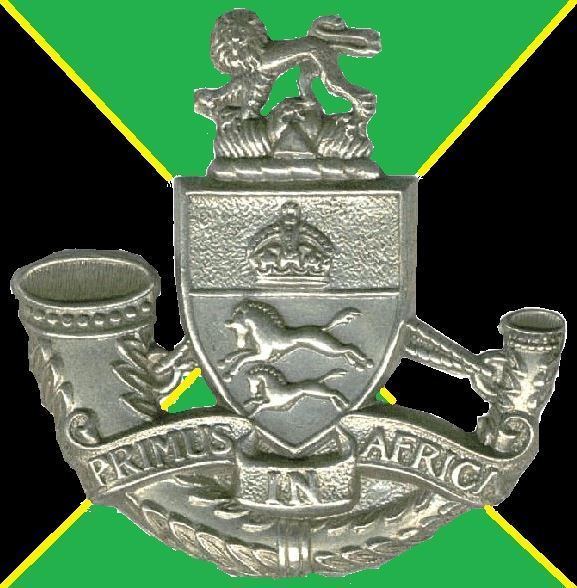Active May 1854 to present | Country South Africa Role Motorised infantry | |
 | ||
The Durban Light Infantry is a Motorised Infantry regiment of the South African Army. It lost its status as a Mechanised infantry regiment in 2010 in line with the rationalisation of resources. As a reserve unit, it has a status roughly equivalent to that of a British Army Reserve or United States Army National Guard unit.
Contents
History
The Regiment was formed as the D’Urban Volunteer Guard, in May 1854. In 1859 it became the Durban Rifle Guard. In 1873 it became known as the Royal Durban Rifles. In 1889 it became known as the Natal Royal Rifles (Left half Battalion). In 1895 it became the Durban Light Infantry.
On the constitution of the Union Defence Force in 1912, the Unit became the Durban Light Infantry, renamed the 1st Infantry, (Durban Light Infantry). In consequence the Unit was permitted to add to its badge “Primus in Africa”.
In 1953, King George VI conferred the title Royal on two Regiments being the Royal Durban Light Infantry and the Royal Natal Carbineers, as a recognition of their seniority and service. In 1961 with the formation of the Republic, the title "Royal" was considered incompatible and the Regiment reverted to being the Durban Light Infantry.
Regimental Colours
At the centre of the 'Regimental Colour' is the badge worn by the Regiment since 1961. It consists of the recognised Infantry Silver Bugle with tassels and a shield with two wildebeest and a crown. The wildebeest are symbolic of the Province, while the crown retained as a traditional device is reminiscent of the title “Royal” bestowed upon the Regiment by King George V in 1935.
The words “Primus in Africa” are superimposed within a scroll.
The crest is composed of a lion passant guardant on three mounds – the centre mound being charged with a pyramid. The lion is symbolic of strength, courage and fortitude. The three mounds are symbolic of the battles fought in World War II – Monte Stanco, Monte Peza and Monte Sole/Caprara. The pyramid is symbolic of the 1941–1943 Egyptian Campaign.
The garland which surrounds the coloured badge comprises the Thistle of Scotland, the Tudor Rose of England and the Shamrock of Ireland – symbols taken from the old colour – and the other two flowers, the Protea, the National flower of South Africa, and the Strelitzia, the flower of Natal (now KwaZulu-Natal).
Active Service
- South Africa, Anglo-Zulu War 1879
- South Africa, Anglo-Boer War 1899–1902
- Relief of Ladysmith 1900
- Natal, Bambatha Rebellion 1906
- South West Africa 1914–1915
- East Africa 1916–1918
- Rand Miners’ Revolt 1922
- World War II
- Western Desert 1941–1943 (See 1st SA Infantry Division)
- Bardia
- Gazala
- Alamein Defence
- Alamein Box
- El Alamein
- Italy 1944–1945
- Casino II
- Florence
- Gothic Line
- Monte Stanco
- Monte Pezza
- Sole/Caprara
- Po Valley
- South West Africa – Namibia 1976–1994, five tours.
- Internally in South Africa in support of the SAPS (SA. Police Service) in the following actions;
- 1949, 1960, 1961
- 1985, 1986, 1987, 1989, 1991, 1992 (mainly rural areas)
- 1994 Elections.
- 1996 Elections.
- 1999 Elections.
- 2006 Op in Burundi. Detached members to Standing Army control structures.
- 2007–2014. Internal operations.
Regimental Headquarters
The regimental headquarters of the DLI has been declared as a National Monument.
Peacekeeping deployments and training
The Regiment is being deployed in Africa, Burundi, DRC; in support of the United Nations and African Union mandate
All members of the Regiment are volunteers, with employment in the civilian roles, they fulfil their responsibilities and duties on top of their duties and responsibilities to their Families and Employers. An enormous commitment to the safety and security of the Republic of South Africa.
Training is mandatory with the current requirements of Equality and Equity in line with the SANDF Policy. The duration of training places an enormous pressure on members to get Employers to relieve them to attend the courses and training exercises.
Regimental history
"Durban Light Infantry" by Lieut Col AC Martin MC VD BA (Cape) Hon.Ph.D (Natal) was published in 1969. It is out of print.
An illustrated history of the 150 years of the Regiment has been prepared by Prof. Brian Kearney, Mr Dave Matthews and Lieut Col "Bill" Olivier SM MMM JCD (Retd.). The book is being sold by the Headquarters Board.
